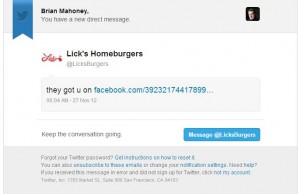Phishing is a new word but it’s very popular these days. What does it mean? Phishing is an attempt to trick people out of their social network or email passwords. Here’s now it works.
This morning, a company that we follow on Twitter sent us a direct message. A direct message on Twitter is much like an email between two Twitter users. Here is what the message looked like:

How would you know this is a phishing attempt? This direct message has a link in it, that’s a key give-away. Also, check how Lick’s used ‘u’ instead of ‘you’. Would a company send out a message with bad grammar in it? That is a second clue. Third, this message was received on Twitter. Why would Lick’s include a link to Facebook in a direct message on Twitter?
Don’t EVER click on a link in a message like this. What happens if you do? If you do click on a link in a phishing email, you will be taken to a page that looks very much like a Facebook or Twitter page. That page, which isn’t a real Facebook or Twitter page, will ask you to log in to your account. Because the page is extremely well made and looks identical to a Facebook/Twitter log in page, people often log in. At that point, the fake page steals your account, changing the password as it does, and starts sending out messages or posts using your name.
Since it seems that these messages are coming from you, your friends click on the link in the message and the fake site gets even more passwords. The circle gets much larger with each click.
Sometimes these links lead to sites that install software on your computer that will steal your personal information, your banking passwords, things like that. Everyday there are new phishing emails sent out, new phishing posts on Facebook and Twitter and, unfortunately, new users who are tricked into clicking on the links. Watch out for this trickery, folks.
Thanks for reading!
